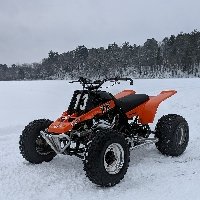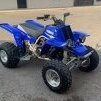-
Posts
1,505 -
Joined
-
Last visited
-
Days Won
22
tfaith08 last won the day on February 2
tfaith08 had the most liked content!
About tfaith08
- Birthday 01/02/1990
Profile Information
-
Gender
Male
-
Location
SW Alabama
-
Interests
Music composition, motorsports in general, MX
Previous Fields
-
My Banshee (optional)
06 SE, long travel, redline race gas serval.
Recent Profile Visitors
4,290 profile views
tfaith08's Achievements

HQ Captain (3/5)
232
Reputation
-
Burnt out. Miss pro racing. I’m going back. Sent from my iPhone using Tapatalk
-
To really get down to it, a longer shock is typically associated with a higher shaft speed. That can make it easier on the shock builder (Ben does good work) but it doesn't always make a huge difference. To be completely honest, having the arms strong enough and of the right width is 95% of what you want to look for if you’re going to build a top notch setup. Once you get in a good ballpark on leverage ratio, that’s good enough. The geometry of the arms isn’t THAT important. I used to think it is, but it really isn’t. When people say they’re developing a-arms, they’re really just getting the shocks dialed in for it and building charts. Arms are simple; they just hold the loads introduced into it. If you build a set of lower arms out of .095 chromoly or .125 steel and you know the design is okay, it's gonna last. it just has to be strong enough to handle braking forces (which puts the front tube in tension and the rear in compression) and bending forces. It’s comically easy to do. To get down to it, the main reason most people don’t develop arms is because of the return on investment as quantity changes. My cost to make a single set of top tier arms is around $950. To make 50 sets drops that price to either $486 or $468, I don’t remember which. Thats $24k of an investment that I’ll sit on for years when I could put that money elsewhere and make even more. There are a lot of rules of thumb in suspension that I’ve heard over the years that are rooted in general advice and nothing more. 2:1 leverage ratio being perfect is absolutely one of those things. I very much don’t like Alba, but fireball and Lonestar are good for sure. Just keep in mind that a damper is doing all the work and getting next to no credit. The shocks you get are built off of charts that may be 20 years old. A good damper on cheap arms will annihilate a bad damper on good arms. Sent from my iPhone using Tapatalk
-
I don’t have a problem with fireball. I don’t think their shock program is up to date, but it’s definitely not bad from what I’ve dealt with. I do have a problem with occasionally wanting to rant about suspension when I have a little to drink and it’s quite possible that I did a shit job of saying something. Can you be more specific? Sent from my iPhone using Tapatalk
-
I’ll weld spider webs back together if you’ll hold the ground to it Sent from my iPhone using Tapatalk
-
Figured I’d bring up some of the stuff that has been hitting my desk lately. A chassis designed to use equal length arms to eliminate bump steer will in fact make it easy to eliminate bump steer, but you’re giving up everything that helps you maintain corner grip. On paper, I’m coming up with around a 20% loss in grip on average for the frames I have a model for. Some of them peak around a 40% loss in grip. Bump steer is fine in some circumstances. I like no bump steer for the lower 80% of the travel and then a touch of bump in. This helps keep it straight on hard hits. Everybody talks about straight line bump steer but nobody talks about when the bars are turned, which is a VASTLY more important matter. I’m getting close to trade secrets here but suffice it to say that eliminating bump steer while turning can cost you seconds. Not tenths. Seconds. Give the tire what it wants, not what Instagram hashtags tell you that it should want. A year or two ago, I would have told you everything I know on the matter but after having another chassis builder tell me that I needed to come read this guide (ya know, the one I wrote) and learn a few things, I’m now aware that I’m helping an asshole. I have zero tolerance for rude people so if you want to know more about this, PM me or find me on facebook. People like 250R rake (which is technically called wheel recession angle or WRA) but that comes at a cost. Higher WRA of around 15 degrees or so can cause a lot of dive under braking. Add in the extra weight of something that isn’t a 250R and the issue gets worse. If you can work with it then the extra comfort and compliance can be worth the trade off, but you have to work with it (weight on your feet under braking, not into your hands). There are about 6-7 things to look at with WRA but the gist is that heavier riders need less, heavier braking needs less, and a shorter wheelbase needs less. For the 800th time, no wheel spacers ever. The shock matters more than the arm. With the shock, the spring has one job: to hold the load introduced to it. The valving controls how fast the spring gets back to its steady state when the load changes. If it’s rough as fuck, 95% of your issues are either because your tire pressure is off, your ride height is off, or your valving is off. It is VERY rarely the spring(s). If someone quotes hooke’s law (a sign they don’t know shit) then ask how that changes with velocity. Even if you don’t know the answer, it’ll let them know they’re at the end of their rope. I’ll be back in about a month to bitch about something else. Sent from my iPhone using Tapatalk
-
Have you set the Elka to ride height? Sent from my iPhone using Tapatalk
-
If you’re trail riding then you’ll want around 7.5-8” front ride height (depending on terrain). That measurement is on the lower frame rails just before they kick up toward the lower arm mounts. You need get on it and have someone measure it for you. Make sure the tires are at the pressure you intend to run and you have fuel in it. The main thing you look for on ride height is whether it likes to tip or roll. As you go higher, it’ll want to transition from rolling to tipping in the corners. 1/4” can be a noticeable difference. As a side note, where your weight is being supported in a corner is a huge factor. If your ass is planted on the seat and your feet are still on the pegs, it makes nearly zero difference if you lean with your shoulders. Putting the weight on your inside foot and trying to squat down on that foot is probably the single most important thing you can do for corner speed. If you’re drag racing, I know the math and dynamics but not the practice. You’ll have to ask someone else. Sent from my iPhone using Tapatalk
-
I personally think you need to figure out what you really want to do with it and then go from there. Chasing down a race build is fun, but everyone has a point where they back off from it. If you can enjoy it before you hit that point (wherever that may be) then fuck it, try it out. At the end of the day, it comes down to how much fun you’re going to have for the money. I have more fun riding with friends but I can’t stay away from endurance racing to save my life. To each their own. Sent from my iPhone using Tapatalk
-
It is. People argue with me about it all the time but there isn’t another way to get ride height. If it’s too stiff, you won’t use all the travel. If it’s beating you to death then your valving is off. Sent from my iPhone using Tapatalk
-
Sorry, I just saw that it doesn’t have an evil chamber. Just set the pressure to get ride height. Sent from my iPhone using Tapatalk
-
The Evol chamber should be 2-4x the main chamber. I’ve never seen a main chamber need more than 60psi ever. Set the main chamber to get to ride height. Not for stiffness, not for comfort, not because Carl on Facebook said so, not because anyone else said so. The only job of the air in the main chamber is to get to ride height, same with springs. Before you do that, put it on concrete (or a tile floor, wood, etc.) and put cardboard under the tires. Set the tire pressure exactly how you plan on riding it and get on it. Bounce up and down while turning the bars and then settle slowly into your riding position. Have someone else measure the height under the lower frame rails. Rear is under the pegs, the front is on the flat part of the frame just before it angles up to the lower arm mounts. Your starting target should be around 7” in the rear and 7.5” in front. The difference in rear vs. front height is rake, so .5” rake in this case. More rake allows for better compliance on rough terrain at speed. Less rake keeps it flatter under braking. If it wants to roll excessively or take any static load well, add Evol pressure. If that doesn’t solve it, add ride height. If it wants to tip, lower the front ride height. If that doesn’t solve it, lower Evol pressure. Every ride height change you make affects alignment so you’ll want to double check that. Set the adjustments in the middle. If it’s rough on single impacts at speed, lower high speed compression. If it’s fine, turn it up until it isn’t, then back off a notch. As you change the high speed compression, you should also change the rebound to a degree. If I do 3 clicks on HS, I usually do 2 on rebound. For braking, hard cornering, and general riding, low speed is what you’ll want to focus on. Sent from my iPhone using Tapatalk
-
What tires do you have on it now? Sent from my iPhone using Tapatalk
-
You can wait to see how it goes or I can tell you. It’s a drastic difference if you’re going to be pushing it any at all. With 20” tires, it cuts feedback by around 85% depending on the tire pressure you run at. It’s fairly easy to calculate. Stock offset works best with around 24” tires. Sent from my iPhone using Tapatalk
-
You don’t need to know the brand for parts replacement. Match the heims by thread size and pitch. Some brands use standard because it’s easier to source misalignment spacers (also called top hats or caps) that reduce down to metric. Finding a 10mm misalignment spacer for a 12mm heim can be a pain if you care about how they look or if pricing becomes an issue. Match the ball joint by size, taper, and head angle. Head angle is almost always either 0, 15, or 30. Most aftermarket arms for a banshee, blaster, and warrior upper ball joints use a 30 degree head angle, but those look like 0 or 15. Go have a look at HSD’s website for a little bit and you can pretty well match them with a little effort. They have blueprints for most replacement hardware. Sent from my iPhone using Tapatalk
-
Add 4/1 rims to that. They’ll make a bigger difference than you’ll believe. You’ll have the engine out and most of the suspension apart, may as well cut the extra tabs off the frame and gusset it and have it powdered. I can help you out on cleaning the frame up if you can get it to me in Ohio. Other than that, a cut harness and a good set of nerfs and you’ll be getting close to a really nice build. Sent from my iPhone using Tapatalk









